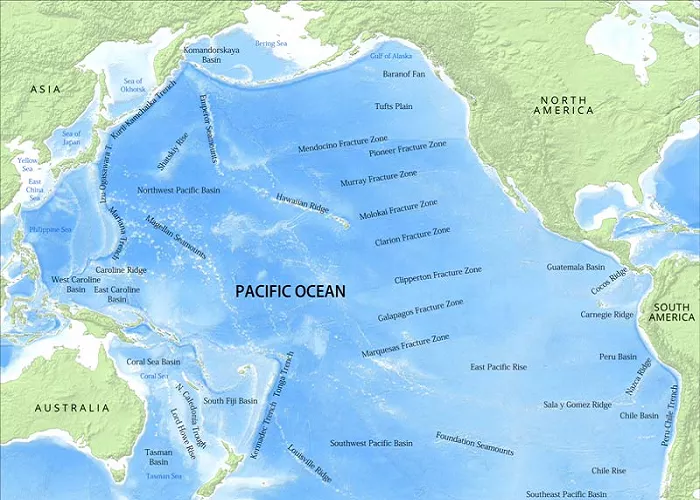The Pacific Ocean’s vast expanse reaches from the Bering Strait, which connects it to the Arctic Ocean, down to the Southern Ocean near Antarctica. Its western boundary includes the eastern coasts of Asia and Australia, while its eastern boundary encompasses the western coasts of North and South America. Notably, the Pacific Ocean meets the Atlantic Ocean at the Strait of Magellan and the Drake Passage, and it connects with the Indian Ocean around the Malay Peninsula.
Geographic Location and Boundaries
The Pacific Ocean is situated between four major continents:
- North America & South America (East)
- Asia & Australia (West)
- Antarctica (South)
- Arctic Ocean (North)
It covers about one-third of Earth’s surface, making it larger than all landmasses combined.
Coordinates of the Pacific Ocean
- Latitude: From about 60°N (Bering Sea) to 60°S (Southern Ocean)
- Longitude: From 120°E (near Indonesia) to 80°W (near South America)
How Big Is the Pacific Ocean?
- Area: ~63 million square miles (165 million km²)
- Average Depth: ~12,080 feet (3,682 meters)
- Deepest Point: Mariana Trench (~36,070 feet or 10,994 meters)
Historical Significance
The Pacific Ocean has played a crucial role in human history. In 1513, Spanish explorer Vasco Núñez de Balboa crossed the Isthmus of Panama and became the first European to sight the ocean, naming it the “Southern Sea.” Later, in 1521, Portuguese explorer Ferdinand Magellan, during his circumnavigation of the globe, encountered favorable winds upon reaching the ocean and named it “Mar Pacífico,” meaning “peaceful sea” in Portuguese.
Islands and Archipelagos
The Pacific Ocean is dotted with more than 25,000 islands, more than all the other oceans combined. These islands are primarily grouped into three regions:
- Micronesia: Located north of the equator and west of the International Date Line, this region includes the Mariana Islands, Caroline Islands, Marshall Islands, and the islands of Kiribati.
- Melanesia: Situated to the southwest, Melanesia encompasses New Guinea (the world’s second-largest island), the Bismarck Archipelago, Solomon Islands, Vanuatu, Fiji, and New Caledonia.
- Polynesia: This expansive region stretches from Hawaii in the north to New Zealand in the south and includes Samoa, Tonga, the Cook Islands, and Easter Island, among others.
Climate and Currents
The Pacific Ocean’s vast size influences global climate patterns. Its surface water temperatures range from about -1.4°C (29.5°F) near the poles to around 30°C (86°F) near the equator. The ocean’s currents play a significant role in regulating temperatures and weather patterns. For instance, the North Equatorial Current moves westward along latitude 15°N, turning north near the Philippines to become the warm Kuroshio Current.
Additionally, the Pacific Ocean is home to the “Ring of Fire,” a horseshoe-shaped zone characterized by frequent earthquakes and volcanic activity. This area contains over 75% of the world’s active volcanoes and experiences about 90% of the world’s earthquakes, making it a significant region for geological activity.
Environmental Challenges
Despite its vastness, the Pacific Ocean faces numerous environmental challenges. Climate change has led to rising ocean temperatures, contributing to coral bleaching and the loss of marine biodiversity. The ocean has absorbed about 90% of the excess heat from increased carbon dioxide emissions, leading to significant warming of its upper layers.
Overfishing and pollution, including the accumulation of plastic debris, pose additional threats to the health of the Pacific’s ecosystems. Conservation efforts are underway in various regions to protect and preserve the ocean’s rich biodiversity and resources.
Conclusion
The Pacific Ocean is a vast and dynamic body of water that plays a crucial role in Earth’s climate, geography, and history. Its immense size, depth, and biodiversity make it a subject of continuous study and exploration. Understanding the Pacific is essential for appreciating the complexities of our planet and the interconnectedness of its natural systems.

